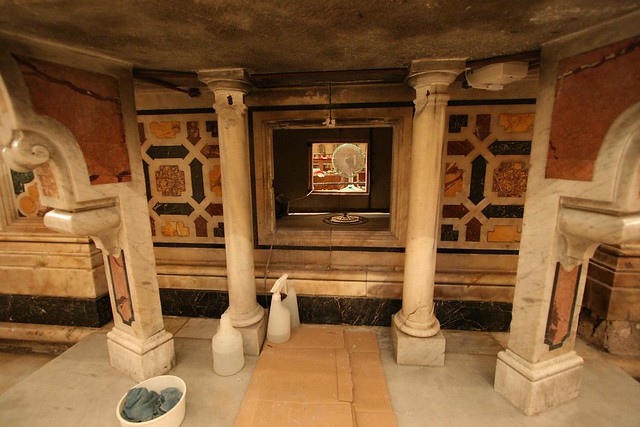Tonight is our last night in Sorrento and I'm sorry to say we never had enough sunshine in which to enjoy our balcony and pool. But we have had a good time nonetheless and seen some interesting sights. We decided to ditch Pompeii after realizing we didn't care quite enough about it to drive almost all the way to Naples and endure the summer crowds and prices. But we made it to our other three sights and enjoyed them all.
Wednesday was a really long day of driving and sightseeing. David was a champ. We drove a couple hours along the winding roads of the famed Amalfi Coast (a World Heritage Site for its views), then continued on another hour to the archaeological site at Paestum.
Amalfi Coast Drive
The Amalfi Coast Drive winds its way around the Sorrento Peninsula with curve after curve of narrow road overlooking the sea. It passes through several villages that nestle into the cliffsides, among which Amalfi and Positano are the most famous.
The route requires a lot of concentration, skill and endurance from a driver but David did a fantastic job. Oncoming traffic tends to drift over the center line, large buses take up the entire road around some corners, and there are often parked cars in the way. It's a continual obstacle course. But somehow there is order in the chaos and it all works. The buses honk their horns when approaching a tight curve, there are convex mirrors to help you on the blind bends, and the cars drifting over the center line leave you just enough room not to hit them.
And of course it's all worth it because the scenery really is beautiful:





Paestum
Paestum is a fantastic archaeological site that centers on three Greek temples dating from the 6th and 5th centuries BCE. I was really impressed with it when I researched it for a website article awhile back and hoped I would get to visit it in the near future. Hooray, now I have!
It was just as cool as I'd hoped and the only Greek temples we've seen in person. Unlike Pompeii Schmompeii, the site was not exorbitantly priced or overcrowded and it had a relaxed feel about it. You could wander off the path through tall grass and climb on any of the ruins except the three temples. We chased lizards quite a bit. Fellow tourists were few, but there were about four huge groups of school kids (Italian and French) on a field trip. The museum is excellent too, with a large collection of Greek tomb paintings.
A few pictures from our visit:






Paestum is out in the middle of nowhere, and not a very attractive nowhere. The landscape is lovely: close to the sea with thick forests and mountains nearby. But the towns are run down and poor and we saw prostitutes along the country roads! We could hardly believe it, but we had read that southern Italy is known for this.
Amalfi
On a happier note, we stopped at Amalfi on our long drive back to Sorrento. It was getting late by then (after 5:00) so we didn't spend too much time there, but it looked like a nice town that deserved its popularity.

Naturally, I was mainly interested in the cathedral. It's Romanesque and very unique, with lots of Arab and Byzantine influences. It overlooks the main square just inside the walls from the harbor. You have to climb 62 steps to visit it!


In medieval times the merchants of Amalfi were wealthy and powerful and had a profitable trade going with Constantinople (Istanbul). And in the Fourth Crusade, a local cardinal swiped the relics of St. Andrew the Apostle from Constantinople. So there's lots of international influence and artistic importance in the cathedral, despite modern Amalfi's more humble role as a small resort destination.

Bronze door from about 1060, donated by an Amalfi merchant and made in Constantinople.
The interior is not terribly interesting because it was given a Baroque makeover that has never been undone. But that's OK because next door are two very interesting sights: the "Cloister of Paradise" from the 13th century and the "Basilica of the Crucifix" from the 9th century. You have to pay 2.50 to enter these, but it's definitely worth it.


The Cloister of Paradise, built in 1226 to house the tombs of Amalfi noblemen. David immediately said, "Looks like Morocco," and he hit the nail on the head - there's a strong Arab influence in the arches thanks to the trade routes and Crusades. The cloister also displays some artifacts, including two Greek tombs and some nice mosaics.

The cloister leads into a 9th-century church, which was once the cathedral. (The "new" cathedral next door was built around 1205 specifically to house the newly-arrived relics of St. Andrew.) There are some really nice frescoes in the side chapels and the main part displays the cathedral's treasures.

Frescoes of saints in the basilica
Stairs from the basilica lead under the present cathedral to the Crypt of St. Andrew, where the relics are still kept under the altar. It's a very pretty space, decorated with paintings donated by the King of Spain in 1660.

I was disappointed to find that the altar was fenced off and covered in cleaning supplies for an apparent restoration/cleaning, but it turned out to be a good thing. The altar was open, giving me a rare glimpse inside an altar that contains relics. It has long been traditional to keep relics inside an altar, but I often wondered exactly how they were stored in there.

Apparently the area is mostly empty, but there's an urn in the floor holding the relics (usually bone fragments). Very interesting!
There are more photos of all the above sights in my Italy Collection on Flickr.

